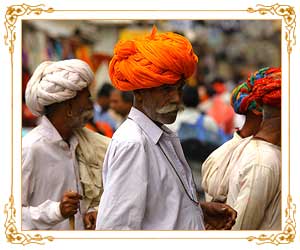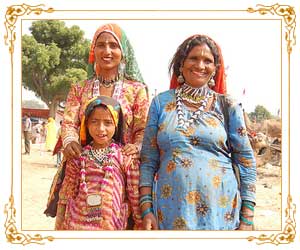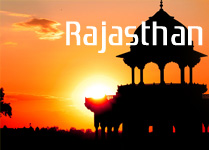 Rajput - The Warrior Class
Rajput - The Warrior ClassValiant and chivalrous, Rajputs were the rulers of the land for a long time and the legends of their medieval concepts and acts of bravery are still sung in Rajasthan. The Rajput rulers were great patrons of arts and crafts and Rajasthan still boasts of monuments of the finest examples of architecture that sprung up during their reign. They still strictly observe their religion and offer sacrifices to their gods and goddesses in order to appease and please them. They have proved formidable foes from time to time. They rose to the elite class of the region and the only reason of their downfall can be attributed to their inter-clan rivalries and internecine wars that often came in the way of their offering a joint opposition to the forces of invaders. Later, Rajputs have been known to serve in the armies of their rulers and acquired land as their compensation not only as a payment for their services but often because they shared a friendly bond and were very loyal to the kings they served.
Brahmins - The Class of Priests
Unlike other parts of India, Brahmins in Rajasthan had to be content with the secondary position, as the dangerous area plagued by invasion and plundering, needed more warriors than intellectuals at the time. Besides the priesthood, Brahmins also served in royal courts and as administrators of the state.
Marwari And Jains - The Trader Class
As usual, the economy of the state mainly depended on its traders and merchants and they were often richer than the rulers themselves. The Marwaris originated in the Shekhawati region and used to serve in the courts of princely states. They were so called as they traveled with the armies of Marwar (now known as Jodhpur) to the eastern side of the country and thus capitalized on the opportunity of making profits in the new markets.
Even today, they constitute most of the major business and industrialist families of the country. Though, Marwaris were very rich they remained discreet on account of their loyalty and respect of the rulers, which they served, and their elaborately painted havelis never stood in competition with the affluent palaces of the royal class. It was their way of expressing their gratitude to the princes and kings who had honored them, time and again, with a title of tazimi-sardar, which was very rarely given to anybody as it made allowances for the title-owner to continue sitting in the presence of the Maharaja and to wear gold on his feet (a privilege accessible only to the immediate circle of the royal family).
Jains, the only other mercantile community that enjoyed as much influence in the courts of the Rajput rulers and often played an important political role, however, built some superlative marble temples dedicated to their tirthankaras at Ranakpur, Dilwara at Mount Abu, Chittaurgarh, Jaisalmer, Jodhpur and Bikaner. Though they observed austerity in their lifestyles, their temples and havelis at Jaisalmer were enviable and grander with delicate stone carving work than many of the palaces of the region.
Jats And Bishnois - The Pastoral Class
The importance of the pastoral side of Rajasthan that involved farming and cattle rearing cannot be underestimated considering the rough weather conditions and hostile climate of the region. There is much folklore about the local heroes, generally a sub-group of Rajputs known as Jats, who sacrificed their lives for the protection of their village communities. A hardworking race, these people are spread over in the regions of Punjab, Haryana and Rajasthan and were once the rulers of Bharatpur and Dholpur and are known for their skills and farming practices of turning even the most arid lands into the fertile fields.
Bishnois, known for their passion to conserve both plant and animal life, follow the paths of a local saint, Jamboji, who instructed them to protect their trees and cattle even at the time of famine, some centuries ago. They gained popularity when innumerable Bishnois refused to let the soldiers cut the trees in their area and did not deterred even when they were dealt with an iron hand. They wrapped themselves around their beloved trees and welcomed death from the soldiers' hand rather than allowing them to cut the trees while they were still alive. Today, they have become the icons for the conservationists. Bishnois men wear a distinct white turban while their women dress up in colorful garments and an ornate nose ring.
Muslims - The Craftsmen Class
Muslims came to Rajasthan as invaders but soon deserted the arid land to more luring places in the east. However, there were some who settled down here and indulged in agriculture such as Kayamkhanis and Meos, especially in the Shekhawati belt, where the Kayamkhani nawabs once had substantial influence. However, only one Muslim kingdom of Tonk survived in the region marked by its feudal system. It has now become a flourishing commercial area. Muslims also served in the courts of the princely states under the Rajput rulers and both the religions flourished together quite amicably.
Yet, undeniably, most of the Muslim population were artisans of good repute and master craftsmen and were kidnapped from the trading caravans passing through the area to serve the princely kingdoms and even today, they dominate the artistic side of Rajasthan, in the fields of painting, dyeing, printing, bangle and jewellery making and paper manufacture. The Bohras, mercantile Muslims who came from Gujarat occupy southeast Rajasthan in large numbers.
The Tribals
 Natives of the barren hills of Rajasthan, these tribals are known for their bravery and zest with which they celebrate their festivals. Minas were once the rulers of the region, which Kachchwahas won through treachery, to create Amber. Largely agriculturists now, they still hold the honor of anointing the head of the Kachchwaha clan and used to serve as guards to the Kachchwaha treasury kept inside the Jaigarh fort, while the reigning Kachchwaha rulers were led only once a year to the treasury to choose anything from the vast collection of jewellery there and that too blindfolded.
Natives of the barren hills of Rajasthan, these tribals are known for their bravery and zest with which they celebrate their festivals. Minas were once the rulers of the region, which Kachchwahas won through treachery, to create Amber. Largely agriculturists now, they still hold the honor of anointing the head of the Kachchwaha clan and used to serve as guards to the Kachchwaha treasury kept inside the Jaigarh fort, while the reigning Kachchwaha rulers were led only once a year to the treasury to choose anything from the vast collection of jewellery there and that too blindfolded.Bhils of Chittaurgarh, Banswara and Dungarpur, still lead a primitive life and are poverty stricken. Known to be brave and trustworthy, they once helped the Sisodia rulers to escape from the Mughals and taught them the art of concealing themselves in the hills.
Other tribals include the Sahariyas, people of the forest who have degraded from being the elite class to that of severely poverty stricken and the Gerasiyas, who have managed to survive by singing and dancing for their guests.
Nomads - People With No Homes
These people are akin to gypsies who travel in large groups, often on a cyclical, seasonal basis, and move around providing their particular services for people in settled communities. Most of them are Gadoliya Lohars, blacksmiths known for their decorated carts. They repair and work with iron and other metals,and make everything from a shovel to a pair of scissors.Banjaras, were nomadic caravan runners who traveled with balaads or oxen-laden caravans. A lakhi or one hundred thousand bullocks leading a caravan has also found its mention among their caravans. However, as these caravans are of no use today, they now live a semi-nomadic life and drifted to other means of livelihood. Rabaris travel in the desert in search of pastures for their flocks of sheep and camels while there are Nayaks who are entertainers, Kanjars, Sansis, Nats and the well-known Kalbeliyas, a group of snake charmers who have gained immense popularity for their unique dance forms and no more travel on foot or in carts but around the world in jets.














